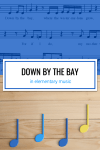I was looking back through old blog posts, and I was shocked to see that I’ve never written about the song Down by the Bay. I used to sing this song every year with my students, coinciding with the year that they learned about rhyming words.

This has so many benefits; it crosses curriculums, students can practice call and echo form, and it gives students the freedom of expression as they create their own lyrics to the song.
CALL AND ECHO FORM
The logical step after learning about same and different parts in music, is to learn about call and echo form. My students practiced echoing starting in Kindergarten, but it wasn’t until first grade that we defined it as a musical form.
One of the best ways to ensure that students don’t sing along with you during the “call” section, is to make it a habit to sing for them, but not with them. As John Feierabend states in his latest book, Feierabend Fundamentals:
The significance of not singing with the class cannot be overstated. When teachers sing with their students, students hear one pitch at a time and repeat each pitch a split second after they hear it. The primary difficulty with allowing this “split second singing” is that students might not develop the ability to truly remember or retain a tune.
Feierabend Fundamentals, 2018
If you make this a habit from the beginning, your students will be more likely to quickly grasp the concept of echo-singing, thereby making call and echo songs more manageable. Another added benefit is that, when students sing on their own, you’re able to better identify whether or not they’ve retained the tune, as they won’t have your voice backing them up.
SINGING WITH SIGN LANGUAGE
First grade was also the year that I taught my students a song in sign language. I didn’t use Down by the Bay for this, but I think it would work wonderfully. The American Sign Language Dictionary is a wonderful resource for this. You search for the word you want, and a video pops up demonstrating that word. If you choose to use sign language, I’d encourage you to reach out to someone in the Deaf community to see if they’d be interested in presenting the song to your class.
To learn some useful tips for using ASL in the music classroom, visit this post from Elizabeth at Organized Chaos.
CREATING LYRICS
First, be ready to write down your students’ responses. I have no doubt that your students will surprise you with their creations. Each time you write down a new lyric, have students sing it back to you (they get a kick out of this). If you’re looking for a bulletin board idea, this could be it! Have students draw and color pictures showing their new lyrics.
You can also use this song as part of a public informance. Be sure to highlight in your program notes that students learned about form using this song. And of course, don’t forget to include all the new lyrics they created.

